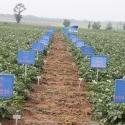09 Dec 2014
Soil potassium supply capacity and relation with cotton yield and fiber quality in main cotton areas in North China
In order to realize soil potassium status and supply capacity as well as their relation with cotton yield and quality in the main cotton areas in North China, surface soil (0-20 cm), cotton plant and lint samples were collected and analyzed from representative cotton fields in Pinyuan County of Shandong province, Weixian County of Hebei province and Changji city of Xinjiang province in 2012-2013. Results showed that in Piyuan County of Shandong, soil exchangeable K was 100 to 200 mg • kg-1 in more than 50% of soil samples, more than 300 mg • kg-1 in 23% of samples, with an average of 217 mg • kg-1. In Weixian County of Hebei, soil exchangeable K was 100-150 mg • kg-1 in 53% of soil samples, <100 mg • kg-1 in 22% samples, with a mean of 128 mg • kg-1. In Changji city of Xinjiang, more than 2/3 samples had soil exchangeable K of 150-300 mg • kg-1,and 25% samples had more than 300 mg • kg-1, with an average of 232 mg • kg-1. Soil K supply capacity, represented by uptake K of aboveground plants, was 120-140 kg • hm-2 in 68% sites with a mean of 128.2 kg • hm-2 in Pingyuan Couny of Shandong, 80-120 kg • hm-2 in 65% sites with a mean of 105.1 kg • hm-2 in Weixian County of Hebei, 150-300 kg • hm-2 in 92% sites with an average of 213.6 kg • hm-2 in Changji city of Xinjiang. The average K uptake by aboveground plants needed for producing 100 kg of lint cotton was 9.77, 7.82 and 12.25 kg, respectively, in sites of Shandong, Hebei and Xinjiang. There were positive linear relationships between soil exchangeable K and lint cotton yield and aboveground K uptake when soil exchangeable K was in the low level, but no positive relationships existed when soil exchangeable K was in the high level. There was significant relationship between uptake K by lint cotton and cotton yield in three locations. There was no consistent relationship between uptake K and quality indices.




